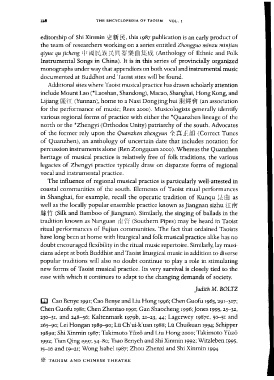Page 168 - The Encyclopedia of Taoism v1_A-L
P. 168
THE ENCYCLOPEDIA OF TAOISM VOL. I
editorship of Shi Xinmin 'SI.: i'Jf ~, this 1987 publication is an early product of
the team of researchers working on a series entitled Zhongguo minzu minjian
qiyue qu jicheng r 11ivXj B!; fii;( ~ rllJ (,~ ~ illl !R J& (Anthology of Ethnic and Folk
Instrumental Songs in China). It is in this series of provincially organized
monographs under way that appendices on both vocal and instrumental music
documented at Buddhist and Taoist sites will be found.
Additional sites where Taoist musical practice has drawn scholarly attention
include Mount Lao (*Laoshan, Shandong), Macao, Shanghai, Hong Kong, and
Lijiang rmn (Yunnan), home to a Naxi Dongjing hui 1IPJ*~ VI (an association
for the performance of music; Rees 2000). Musicologists generally identify
various regional forms of practice with either the *Quanzhen lineage of the
north or the *Zhengyi (Orthodox Unity) patriarchy of the south. Advocates
of the former rely upon the Quanzhen zhengyun 1: J"!; lE 1ffi (Correct Tunes
of Quanzhen), an anthology of uncertain date that includes notation for
percussion instruments alone (Ren Zongquan 2000). Whereas the Quanzhen
heritage of musical practice is relatively free of folk traditions, the various
legacies of Zhengyi practice typically draw on disparate forms of regional
vocal and instrumental practice.
The influence of regional musical practice is particularly well-attested in
coastal communities of the south. Elements of Taoist ritual performances
in Shanghai, for example, recall the operatic tradition of Kunqu LJ:. Hl:J as
well as the locally popular ensemble practice known as Jiangnan sizhu iI l¥J
,~it (Silk and Bamboo of Jiangnan). Similarly, the singing of ballads in the
tradition known as Nanguan lid"f (Southern Pipes) may be heard in Taoist
ritual performances of Fujian communities. The fact that ordained Taoists
have long been at home with liturgical and folk musical practice alike has no
doubt encouraged flexibility in the ritual music repertoire. Similarly, lay musi-
cians adept at both Buddhist and Taoist liturgical music in addition to diverse
popular traditions will also no doubt continue to play a role in stimulating
new forms of Taoist musical practice. Its very survival is closely tied to the
ease with which it continues to adapt to the changing demands of society.
Judith M. BOLTZ
W Cao Benye 1991; Cao Benye and Liu Hong 1996; Chen Guofu 1963, 291-307;
Chen Guofu 1981; Chen Zhentao 1991; Gan Shaocheng 1996; Jones 1995, 25-32,
230-31, and 248-56; Kaltenmark 1979b, 21-23, 44; Lagerwey 1987C, 50-51 and
265--90; Lei Hongan 1989--90; Lii Ch'ui-k'uan 1988; Lii Chuikuan 1994; Schipper
1989a; Shi Xinmin 1987; Takimoto YiiZ0 and Liu Hong 2000; Takimoto YiiZ0
1992; Tian Qing 1997, 54-80; Tsao Benyeh and Shi Xinmin 1992; Witzleben 1995,
15-16 and 19-21; Wong Isabel 1987; Zhou Zhenxi and Shi Xinmin 1994
* TAOISM AND CHINESE THEATRE

